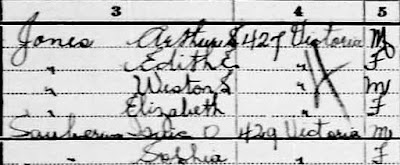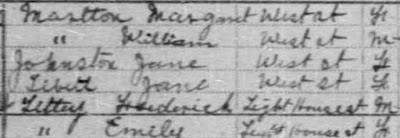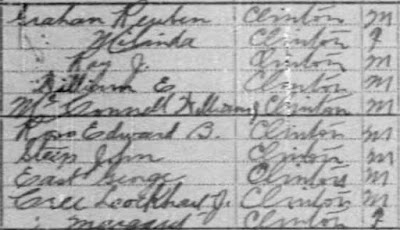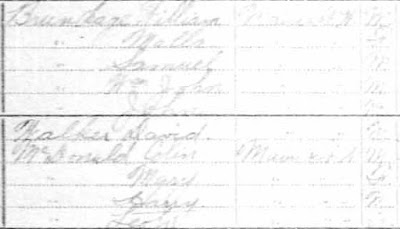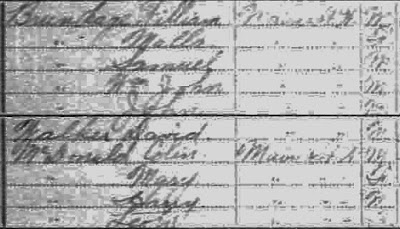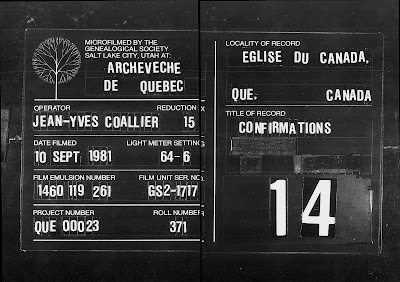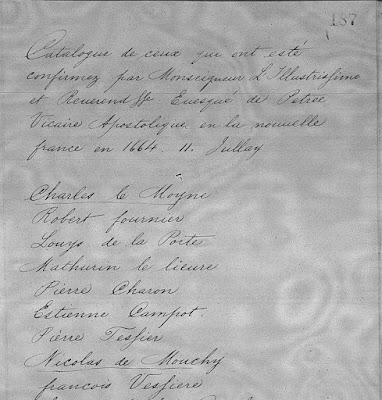
When dealing with land records in Ontario one of the challenges I still struggle with is locating the property when the family lived in an urban area. So when I saw the following post in the Ontario Genealogy Facebook group I decided to give it another go.
"I
have found my 2nd great grandparents, William and Jane Hughes on the
1871, 1881 and 1891 censuses in Orangeville. Is there any way to figure
out exactly where in the Orangeville area they lived?"
There were several good suggestions such as looking on the Canadian County Atlas Digital Project and looking at Ontario city directories like those linked to by The Ancestor Hunt. Out of those suggestions, another clue was provided to help me locate the family in the census. William and Jane Hughes had sons Robert and William were tailors. One person suggested looking at the other census schedules since they provide real estate information.
And that is where I am going to start.
Out of the three Canada censuses mentioned in the original query, the 1871 census of Canada is the only one with surviving schedules beyond the Population Schedule. On Ancestry I started looking for a William Hughes residing in Orangeville with a Jane as a possible spouse and Robert and William in the household. Keep in mind that the 1871 census of Canada doesn't list the familial relationships so we have to often make assumptions as to the relationship or use other records to confirm the connect. I also used Ancestry for several reasons:
- Ancestry has images for the 1871 census available for viewing whereas FamilySearch doesn't. FamilySearch does have the census transcribed but I prefer looking at the image for other clues.
- The URL for the image which Ancestry presents includes details I can use to view the same image on the Library and Archives Canada site.
- The search system on the Library and Archives Canada site for censuses is not as powerful as that found on Ancestry
After searching Ancestry I found one household which fit the information about the family.
Here is the family of William Hughes in the Wellington Centre district (34), Orangeville sub-district (i), on page 66, starting at line 1, dwelling 236, family 236.
 |
| 1871 Census of Canada, Wellington Centre (district 34), Orangeville (sub-district i), Schedule 1, p. 66-67, Household of William Hughes; RG 31; digital images, Library and Archives Canada (http://www.bac-lac.gc.ca/ : accessed 13 Jul 2021); citing microfilm C-9948. |
Now I turned to my own prior blog post "Ontario Concession and Lot in the 1871 Census of Canada" to guide me through the process to locate Schedule 4, Return of cultivated land and products on Ancestry. For that I needed to record the following details:- District: Wellington Centre (34)
- Sub-district: Orangeville (i)
- Page: 66
- Line: 1
Moving through the virtual filmstrip on Ancestry I quickly came to image 54 of 85 which has the image of the Schedule 4 page which references back to page 66, line 1 of Schedule 1 - Nominal Return of Living (AKA the Population Schedule).
 |
| 1871 Census of Canada, Wellington Centre (district 34), Orangeville (sub-district i), Schedule 4, p. 12-13; RG 31; digital images, Library and Archives Canada (http://www.bac-lac.gc.ca/ : accessed 13 Jul 2021); citing microfilm C-9948. |
If this was a rural property I would have expected to see a concession and lot number after the columns with the 66 and 1. Instead there are dashes which leads me to believe the property is within the village of Orangeville. Even then there are bits of information for us.
- William owns the property
- There are 3 acres occupied
- 3 acres have been improved
- 1 acre allocated for pasture
- 1 acre has been used to produce 100 bushels of potatoes
I still don't know where in Orangeville they reside. The directories I did come across were farmer and business directories and I didn't find William Hughes listed with an address. But, based on my own experience, that isn't too surprising. So off to my next stop, the land records.
For this I wanted to look at the Land Record books. Normally I'd start with the Abstract Index books but sometimes the Land Record books include a name index at the front and the Abstract Index books don't. But I don't have a lot, concession, or any other specific about the location. So I took a gamble in the hopes of short-cutting the search.
On FamilySearch I used the catalogue to search for the current county which has Orangeville within its bounds, Dufferin. For the place I typed "Canada, Ontario, Dufferin" to get to the land and property records for that county. Within the Land and property section I selected "Land record of Dufferin County, ca. 1821-1955" to open up the Land Records collection. Scrolling through the list of digitized microfilms I noted that the earlier Orangeville volume "O" books may be indexed. With any luck the index will help me.
I selected DGS 8548530, "Orangeville (indexed) 1825-1863; Orangeville (v. 1) 1841-1869; Orangeville (v. O, indexed) 1864-1869" as a starting place on the hope that William Hughes had land transactions in that time since he was already settled in Orangeville by 1871.
The Town of Orangeville Deeds volume "O" which I was interested in started at image 345 in that digitized microfilm reel.
As
an aside, although the current town of Orangeville is in Dufferin
County in Ontario and not Wellington County, until 1879 Orangeville was
part of Wellington County. Yes, geography can be confusing and
boundaries can shift or be created over time. This can actually be seen when you read the description page of that volume where it is recorded:
"This Register contains, exclusive of the Index 175 pages and is to be used in and for the Village of Orangeville in the County of Wellington for the Enregistration of Memorials, under the provisions of the Act of the Legislature of the Province of Canada passed in the Ninth Year of Her Majesty's Reign..."
In the index I came across a mortgage instrument for William Hughes and wife recorded as instrument 133 on folio 299. This looked promising.
After bouncing through the virtual microfilm images I came to instrument 133 starting on image 525. This was an indenture made on the 20th of February, 1868 by William Hughes of the village of Orangeville in the County of Wellington, Province of Ontario and Dominion of Canada, a weaver, and Jane Hughes of the same place as the first two parties with William Armstrong as the other party.
William and Jane Hughes? That is the couple we are looking for. A good sign.
After reading through a whole bunch of legalese I came across the mention that the property is three acres. Three acres is the same amount of land recorded in Schedule 4 of the 1871 census of Canada for this household. I think I found the property.
A bit further on it states:
"...being composed of Part lot number Eight on the South Side of Factory Street in said Village..."
Just a second!
That's a street name and even a lot number.
This is easy now I though to myself. I just have to put into Google Maps the street name and Orangeville and it will appear.
And no such luck. It looked like there is no Factory Street in present day Orangeville. OK, not a problem. I just have more work to do.
This is where old maps come in handy. A quick search for "old maps of orangeville ontario" (without the quotes) on Google Images brought me to the "2017 - TRAILBLAZERS" page of the Digital Historian Project at the Dufferin County Museum & Archives. On that page I found an early map of Orangeville from 1875 (based on the map filename).
It wasn't too long before I found Factory Street and on the south side of the street there is even a lot 8.
 |
Map of Orangeville, "2017 - TRAILBLAZERS", Digital Historian Project Canada Case Files. (https://digitalhistorianproject.wordpress.com/2017-trailblazers/ : accessed 13 Jul 2021), extract focused on Factory and Centre Streets.
|
Yet where is that street now? Does it even exist? Has it been renamed?
To answer that question I returned to Google Maps to look at the present day map of Orangeville. Using the clues in the older map. With a little bit of create work in Google Maps I was able to align the map to sort of have the same orientation of the old map. Lo and behold, doesn't this area look like that extract from the old map?
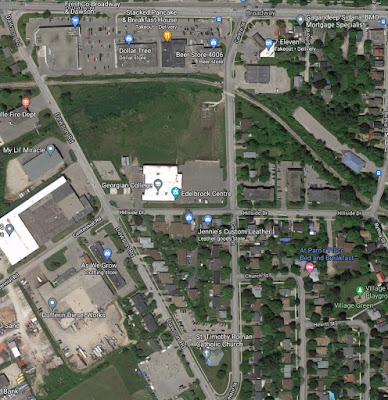 |
Screen capture from Google Maps centred on Hillside Drive and Centre Street, Orangeville, Ontario, Canada (accessed 13 Jul 2021).
|
It seems like Factory Street has been renamed as Hillside Drive. I now had a current street name and with that I can possibly use the Ontario Land Property Records Portal, OnLand, Property search function but I still needed a street number. I used the Street View on Google Maps and guessed that it might be around 5 Hillside Drive.
If you haven't used OnLand yet then you are in for a rough ride initially. It has a bit of a learning curve but the results can be worth it. I'm not going to go into the details of how I found the documents though. That will possibly be for a future post.
So when I put that address into the OnLand Property address search it returned:
PT LT 8, PL 170 AS IN MF138033 ; ORANGEVILLE
as the property details.
There is that Lot 8. It is referenced as part of Plan 170 (PL 170).
I wasn't going to celebrate until I could actually see the Abstract/Parcel Index book page for that property and I see William Hughes listed.
When I looked at in the Abstract/Parcel Register Book under Historical Books for the Dufferin Land Registry Office (LRO) and filtered by Orangeville as the municipality the list was way too short so that filter wasn't going to help me. But I did see that the various "PLAN ###" books didn't have a Township/Municipality assigned. Just great...NOT!
Scrolling through the list I quickly (yay!) found PLAN 170 in Book B113. Opening that book I found it only had 63 pages. I can easily deal with looking through 63 pages.
On image 26 I found the start of the Town of Orangeville, Lot 8, Plan 170 pages.
 |
| Screen capture from the Dufferin LRO, Historical Books, Abstract/Parcel Index for Town of Orangeville, Lot 8, Plan 170, page 1; Ontario Land Property Records Portal (https://www.onland.ca/ui/ : accessed 13 Jul 2021) |
There is the B&S for William Armstrong and wife selling the property to William Hughes on 20 Feb 1868. The instrument is number 132. That is just one instrument before the one describing the mortgage William Hughes took out to pay for the property.
Here is the start of that instrument as found on FamilySearch in the Land Records book for Orangeville, Book "O":
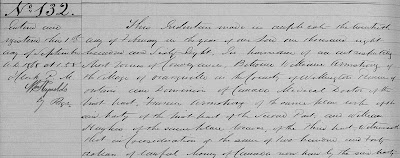 |
| Land records of Dufferin County, ca. 1821-1955, Orangeville (indexed) 1825-1863; Orangeville (v. 1) 1841-1869; Orangeville (v. O, indexed) 1864-1869, instrument 132; Registrar's Office, Orangeville, Ontario; DGS 8,548,530, image 525, FamilySearch (https://www.familysearch.org/ark:/61903/3:1:3Q9M-C3QZ-WF3K : accessed 13 Jul 2021). |
To answer the original question "Is there any way to figure out exactly where in the Orangeville area they lived?", yes it is possible. All it took was the combined resources of:
- 1871 Census of Canada, Schedule 1
- 1871 Census of Canada, Schedule 4
- Ontario Land Record books on FamilySearch
- Ontario Land Property Record Portal (OnLand) Historical Abstract/Parcel Index books
- Google Maps
- Google Search
- some effort
- and a bit of luck


